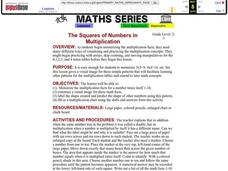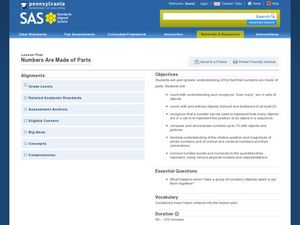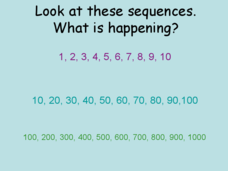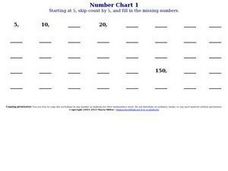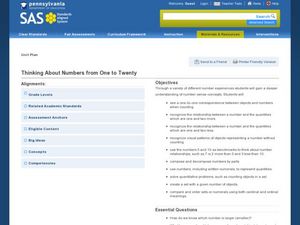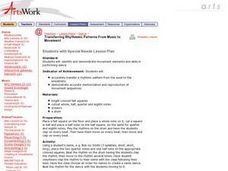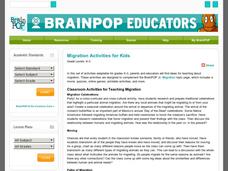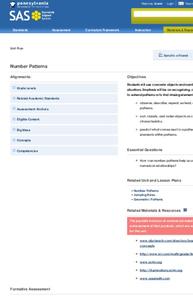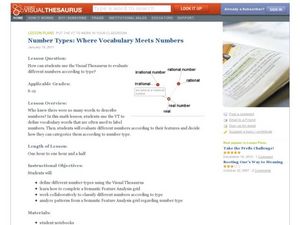Curated OER
The Squares of Numbers in Multiplication
Review multiplication facts and concepts! This clear, and easy to follow instructional activity will help your class to understand multiplication by using arrays and repeated addition. There are strategies to help with memorization and...
Curated OER
Investigation - Adrienne's Pattern Block Angles
Fifth graders investigate possible solutions to a word problem. They explore properties of polygons and right angles. Students demonstrate proper angle measurement. Students discover patterns.
Pennsylvania Department of Education
Numbers Are Made of Parts
Children play with barnyard animal cards to practice composing and decomposing numbers. With their "secret number" of animal cards in a cup, they shake and spill them onto a barn story board, counting how many animals fall in the barn...
Curated OER
Recognizing and Extending Number Sequences
Number sequences and pattern recognition are vital skills for understanding more complex mathematical concepts. Practice determining the rule with your class. Each slide shows a sequence of numbers, they need to work together to find the...
Curated OER
Sequencing and Counting on
This series of slides gives learners an opportunity to count on by 10's in number sequences then discuss how to apply counting on to addition and subtraction problems. Learners count on and back by 1's, 10's, and 100's.
Illustrative Mathematics
Complex number patterns
Start off with the definition of the imaginary number i, then have your class practice simplifying expressions involving powers of i and look for patterns. See how the cyclic nature of powers of i translate to sums of powers of i.
Curated OER
Number Chart 12: Skip Counting by 5
In this skip counting worksheet, students fill in the numbers to complete a pattern of skip counting by 5. Students begin with the number 5 and write the numbers as they skip count to 200.
Pennsylvania Department of Education
Thinking About Numbers from 1 to 20
Help your kindergarteners discover new number-sense concepts and to compose and decompose numbers. Though the resource contains no procedural details, the assessment tool (which you can find in the "printer friendly version") has...
Curated OER
Transferring Rhythmic Patterns From Music to Movement
Students identify and demonstrate movement elements in relation to musical notation. They clap to rhythms, beat on drums, match musical notes to speech patterns and use the rhythms of the their names to create a dance.
BrainPOP
Migration Activities for Kids
For as long as there has been life on earth, animals, including humans, have used migration as a means of survival. This collection of activities supports young scientists as they learn about this behavioral adaptation, encouraging them...
Curriculum Corner
Large "Wh" Words
Help young readers learn which way to pronounce the wh- digraph with this set of word cards. Introduce and sort through these 21 different words as a whole class before having students practice independently or in pairs as a...
Math Worksheets Land
Patterns of Association (Using Data Tables) - Independent Practice Worksheet
Here is a worksheet that belongs in a four-part resource that has learners practice using data tables to calculate percentages. The page has ten problems with different data tables asking to find different...
Houghton Mifflin Harcourt
Fraction Strips
Identify, compare, and order fractions with a hands-on learning tool. Fraction strips are a great way to help young mathematicians understand and visualize fraction values. The worksheet can be made into an activity in which pupils cut...
Curated OER
Number Patterns
First graders use manipulatives to complete and extend patterns. In this patterns lesson, 1st graders complete a pattern with a missing element, extend a pattern, and sort objects by characteristics.
Education Development Center
Consecutive Sums
Evaluate patterns of numbers through an engaging task. Scholars work collaboratively to determine a general rule reflecting the sum of consecutive positive integers. Multiple patterns emerge as learners explore different arrangements.
Math in English
Skip Counting
Help young mathematicians take the next step toward fluent addition with a simple skip counting exercise.
Curated OER
Patterns to the Rescue
Students watch the Cyberchase episode, "The Poddleville Case" and play online games to examine how patterns are sequences that repeat or change in an orderly way. The lesson plan culminates with students creating their own patterns to...
Curated OER
Number Types: Where Vocabulary Meets Numbers
Rational, irrational, real, natural. All these words can refer to numbers. Who knew? Learners use the Visual Thesaurus and a semantic feature analysis grid to examine the different attributes of numbers. Step-by-step instructions for...
Cabrillo College
Elementary Algebra
Hello Algebra! If you're in need of a resource with a books worth of examples and practice problems, this is it. Some topics include linear equations, polynomials and exponents, rational expressions, quadratic equations, and a...
Kelly's Kindergarten
May Daily Activities
Five weeks of daily activities for the month of May! With a new activity for each day of the month, your youngsters will utilize a variety of skills and practice everything from sight words and spelling to counting by twos or coloring...
Curated OER
Addition Properties
Addition becomes much simpler once scholars understand its properties. They examine the commutative property through five equation pairs. For each, the addends have been switched and scholars must fill one in. The next six...
Curated OER
Number Scrolls
Students write the number line. In this numbers lesson, students write numbers in numeric order on a number scroll. They find patterns within this number line.
Curated OER
Using Tens Frames for "Teen" Numbers
Sixth graders practice recognizing teen numbers for the part-whole strategy of bridging to ten. They approach the advanced counting stage to problem solve addition facts to ten utilizing dot patterns on a quinary frame with dot patterns...
Curated OER
Linear Functions
Fifth graders investigate the concept of a function in relationship to how it is used. The concept is essential for the future study of Algebra. They apply the use of patterns with its relationship to functions.


